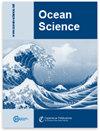拉普捷夫海盐度和温度年际变化的驱动因素
IF 4.1
3区 地球科学
Q2 METEOROLOGY & ATMOSPHERIC SCIENCES
引用次数: 0
摘要
摘要欧亚河流为北极提供了总淡水量的四分之一,维持了覆盖北冰洋表层的持久淡水层。淡水输出控制着北冰洋的分层、环流和整个海盆的海冰浓度。勒拿河提供的径流量最大,在这一系统中发挥着关键作用,因为径流以特别浅的羽流形式流向拉普捷夫海。以前的现场和模拟研究表明,当地风力是拉普捷夫海表面盐度(SSS)变化的一个驱动因素,但对于勒拿河径流和海冰覆盖在造成这种变化中的作用或变化的主要驱动因素还没有达成共识。直到最近,卫星 SSS 数据检索的精度还不足以在北极地区使用。然而,海冰覆盖的退缩和卫星产品开发的不断进步极大地改进了 SSS 的检索,使卫星 SSS 数据在北极具有真正的潜力。在这一地区,基于卫星的 SSS 与原地数据吻合良好(r>0.8),与本研究中使用的再分析产品(r>0.7)相比,在捕捉原地数据中观测到的模式和变异性方面有明显改善。这项研究展示了一种新方法,即在再分析产品中确定拉普捷夫海动态年际变化的主要驱动因素,并测试这些关系是否在卫星 SSS、海面温度(SST)数据和原位观测数据中成立。卫星 SSS 数据有力地证实了再分析产品所提出的观点,以及之前由于原位数据分析的年份和地点有限而引起的争论;即带状风是勒拿河近海或沿岸羽流输送的主要驱动力。东风将羽流限制在拉普捷夫海南部,并将其沿岸迁移到东西伯利亚海,而西风则将离岸羽流迁移到拉普捷夫海北部。本研究使用的所有再分析和卫星产品以及现场数据都证实了这一结论,即在东风和西风机制下的 SSS 模式非常一致。SST 模式还随地带风成分的变化而变化,并驱动海冰浓度的空间变化。本文章由计算机程序翻译,如有差异,请以英文原文为准。
Drivers of Laptev Sea interannual variability in salinity and temperature
Abstract. Eurasian rivers provide a quarter of total fresh water to the Arctic, maintaining a persistent fresh layer that covers the surface Arctic Ocean. This freshwater export controls Arctic Ocean stratification, circulation, and basin-wide sea ice concentration. The Lena River supplies the largest volume of runoff and plays a key role in this system, as runoff outflows into the Laptev Sea as a particularly shallow plume. Previous in situ and modelling studies suggest that local wind forcing is a driver of variability in Laptev sea surface salinity (SSS) but there is no consensus on the roles of Lena River discharge and sea ice cover in contributing to this variability or on the dominant driver of variability. Until recently, satellite SSS retrievals were insufficiently accurate for use in the Arctic. However, retreating sea ice cover and continuous progress in satellite product development have significantly improved SSS retrievals, giving satellite SSS data true potential in the Arctic. In this region, satellite-based SSS is found to agree well with in situ data (r>0.8) and provides notable improvements compared to the reanalysis product used in this study (r>0.7) in capturing patterns and variability observed in in situ data. This study demonstrates a novel method of identifying the dominant drivers of interannual variability in Laptev Sea dynamics within reanalysis products and testing if these relationships appear to hold in satellite-based SSS, sea surface temperature (SST) data, and in situ observations. The satellite SSS data firmly establish what is suggested by reanalysis products and what has previously been subject to debate due to the limited years and locations analysed with in situ data; the zonal wind is the dominant driver of offshore or onshore Lena River plume transport. The eastward wind confines the plume to the southern Laptev Sea and drives alongshore transport into the East Siberian Sea, and westward wind drives offshore plume transport into the northern Laptev Sea. This finding is affirmed by the strong agreement in SSS pattern under eastward and westward wind regimes in all reanalyses and satellite products used in this study, as well as with in situ data. The pattern of SST also varies with the zonal wind component and drives spatial variability in sea ice concentration.
求助全文
通过发布文献求助,成功后即可免费获取论文全文。
去求助
来源期刊

Ocean Science
地学-海洋学
CiteScore
5.90
自引率
6.20%
发文量
78
审稿时长
6-12 weeks
期刊介绍:
Ocean Science (OS) is a not-for-profit international open-access scientific journal dedicated to the publication and discussion of research articles, short communications, and review papers on all aspects of ocean science: experimental, theoretical, and laboratory. The primary objective is to publish a very high-quality scientific journal with free Internet-based access for researchers and other interested people throughout the world.
Electronic submission of articles is used to keep publication costs to a minimum. The costs will be covered by a moderate per-page charge paid by the authors. The peer-review process also makes use of the Internet. It includes an 8-week online discussion period with the original submitted manuscript and all comments. If accepted, the final revised paper will be published online.
Ocean Science covers the following fields: ocean physics (i.e. ocean structure, circulation, tides, and internal waves); ocean chemistry; biological oceanography; air–sea interactions; ocean models – physical, chemical, biological, and biochemical; coastal and shelf edge processes; paleooceanography.
 求助内容:
求助内容: 应助结果提醒方式:
应助结果提醒方式:


